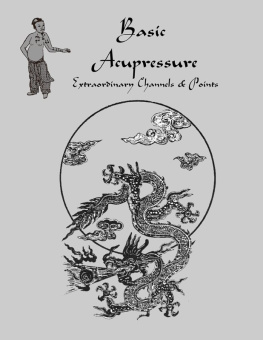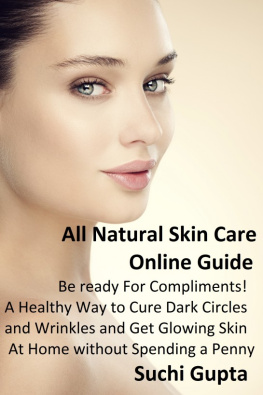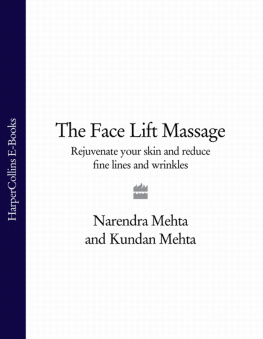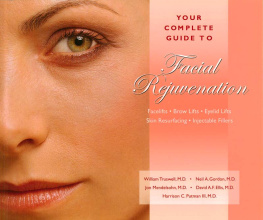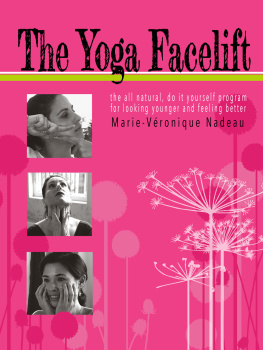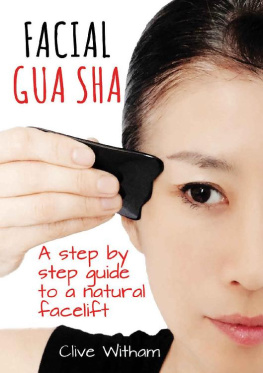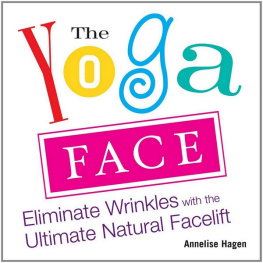Facelift
by Acupressure
BEAUTY AND VITALITY
AT YOUR FINGERTIPS
INTERNATIONAL PUBLICATION
UPDATED SECOND EDITION
INA C NIEMANN
Contents
Copyright and Disclaimer
Introduction
Skin Deep
Western Medicine -Traditional Chinese Medicine
- Yin &Yang
- What is Chi?
- How do we correct our Chi?
What is Facial Acupressure?
The Face as a Mirror of our Organs
Positive Effects of Facial Acupressure
Acupressure versus Surgical Facelift
Face Lines
Face Muscles
Tips for Massaging
Questions and Answers
Acupressure Points 1 to 14
Acupressure Points Summary
Special Cosmetic Points 15 & 16
Other Influences
- Sleep
- Stress & Relexation
- Posture and Attitude
- Nutrition
- Emotions
About the Author
Qualifications and Publication
Impressum
Copyright - Life Balance LLP (Co.Reg.T14LL2506J / ACRA)
All rights reserved. This manual is the property of the author Ina C.Niemann no part of it may be copied, photocopied or reproduced in any mechanical or electronic way without the consent of the author.
Any passages, quotations or other kind of excerpts may only be used under internationally ruling copyright laws and need the permission of the author.
Disclaimer
The author does not dispense medical advice or prescribe the use of any technique as a form of treatment for physical or emotional issues without the advice of a physician, either directly or indirectly.
This book is not intended to replace the services of a licensed healthcare professional in the diagnosis or treatment of illness. Any application of the material set forth in the following pages is at the readers discretion and sole responsibility.
Introduction
Even though the skin is our largest organ about 2 square meter the part on our face accounts for four and a half percent only. Yet it attracts more attention, generates more concern and feeds more commercial enterprises than any other part of the
body. We obviously find it difficult to accept the marks of time gracefully because they affect the way we present ourselves to the world.
Throughout the ages, women have been preoccupied with the attempt to halt or at least slow down the signs of ageing with limited success only. Furthermore, our perception of age is changing continuously. Instead of being associated with seniority, experience and wisdom, old age has become something to be shunned and no effort is spared to keep our face looking young and wrinkle free.
Yet, ageing is a natural, slow and irreversible process of evolution which cannot be stopped. Nevertheless, women and increasingly men are flocking to beauticians, chemists and clinics in search of quick fix cures in order to turn back the clock. Pharmacists and plastic surgeons have become the new gurus to whom people entrust their most exposed and most fragile organ - the skin on their face.
The conventional approach to anti ageing has always been a symptomatic one, focusing solely on the visible symptoms like wrinkles, sagging features etc. However, even a surgical facelift provides a temporary solution only (apart from possible serious side effects) requiring later follow-ups or even corrective measures.
Natural Medicine has no cure for ageing either. However, it is able to offer a gentle long-term approach to tired skin, fine lines and even deep wrinkles. As it takes into account our general constitution as well as the present state of health, it offers us the chance to become actively involved in managing our health and subtly but profoundly changing the way we look.
The techniques explained in this manual will provide you with an easy to learn tool that can be learned in minutes and applied immediately.
Have fun and success in taking care of your-self in an effective and easy yet rewarding way!
Skin deep
Our skin is not only our largest organ, but also weighs twice as much as our brain. It completely wraps around our body - supple enough to allow movement yet, at the same time tough enough to shield us against injury.
It protects the internal organs and retains essential fluids while resisting infection and damaging radiation by the sunlight.
It keeps our internal temperatures constant by conserving heat or cooling the body when necessary.
If thats not enough, our skin takes care of the excretion of toxins and waste material that cannot pass through the kidneys and distributes nutrients and oxygen to the nerves and glands, hair and nails. Last, but not least, it allows any sensory information to travel to the brain be it pleasant or unpleasant like pain.
To do all this, the skin is fitted with unique qualities hair follicles to get sebum to the surface, nerve receptors that are acutely sensitive and elastic tissues capable of expanding by 50 per cent.
In addition, it is extremely adaptable to climates and temperatures, to our moods and our age.
Taking into consideration that our skin is the most expressive and most exposed part of our body, it is only understandable that women and increasingly men are concerned with keeping their skin healthy and glowing while - at the same time - trying to delay the onset of wrinkles as much as possible.
The foundation of the skin is the hypodermis containing fat cells, blood vessels and nerve fibers. Above that, we find the skins support system, the dermis. It not only holds blood vessels, nerve ends, hair follicles, sebaceous and sweat glands and connective tissue but - most importantly - it contains collagen, a protein that gives the skin its bounce and vitality by providing structure and support.
The fact that collagen production declines with age usually results in tired, sagging skin and eventually wrinkles.
While in a teenagers skin the cells are regenerating at a record speed of around 28 days, this will slow down to about 45 days for a woman in her fifties.
Furthermore, menopause might bring a sharp decline in estrogen production leading to a fall of sebum. Consequently, water evaporates easier, resulting in drier skin.
The top layer the epidermis becomes about 20 per cent thinner than during teenage years; the distribution of fatty cells becomes uneven, drooping jowls and a heavier chin might be appearing.
Western Medicine
Traditional Chinese Medicine (TCM)
In order to understand the effect of Facial Acupressure on the face and the body as well, it is important to appreciate the difference between Western Medicine and TCM.
The conventional Western view of the body emphasizes the physical structures and components that interact in a very subtle and complex manner. Anatomy and physiology map these structures from the largest bones, muscles, skin and so on to the smallest the cells and their components. This structural map forms the basis of the model of cause and effect that dominates Western Medicine.
Traditional Chinese Medicine (TCM) engages a very different model. It considers components of process rather than of structure. The human body is seen first and foremost as an Energy system in which various substances interact to create the whole physical organism.


